 Conventional Attack Submarines (S641-651). Service 1964-1996: Daphné, Diane, Doris, Eurydice, Flore, Galatée, Minerve, Junon, Vénus, Psyché, Sirène +15 exported.
Conventional Attack Submarines (S641-651). Service 1964-1996: Daphné, Diane, Doris, Eurydice, Flore, Galatée, Minerve, Junon, Vénus, Psyché, Sirène +15 exported.French Cold War Submarines
La Creole class (1940) | Narval class (1954) | Arethuse class (1957) | Daphne class (1959) | Gymnote test SSBN (1964) | Le Redoutable SSBN (1967) | Agosta SSN (1974) | Rubis SSN (1979) | Amethyste SSN (1988) | Le Triomphant SSBN (started 1989)We continue our dive in cold war French submarines with a later conventional design called the Daphné class. These were not “sous-marins de patrouille” or patrol submarines, but follow-up hunter-killer of the Arethuse class. They were called “sous marins de chasse”, designed for speed and underwater agility and larger, more silent overall. In place of only four, no less than 25 were built over the years, the first laid down in 1958 and the last completed in 1970. They were also the first exported, four to Pakistan, four to Portugal, three to South Africa and four to Spain, some of which were decommissioned as late as 2010. They were an important development and solidified the return of French submarines as an alternative on the international market, facing the German Type 205, 206 and British Oberon class. They were the last of the “old style” streamlined design, replaced in the late 1970s by the teardropped Agosta class.
Development of the Daphné class
In 1950 the French admiralty envisioned a mid-tonnage submarine between 400 and 1,200 tons that would be able to tackle the whole range of future missions on an improved platform. As early as September 17, 1952, the General Staff notified the Technical Service of Naval Constructions (STCAN) on this project, named “2nd class submarine”. It was to be kept modest in size, c700 or 750 tons yet being better armed and more capable than the Arethuse which construction was already planned. This note was signed by Admiral Rosset, former submariner, for a program setup to start FY1956.
He wrote a set of desirable characteristics regarding propulsion, detection, silence and maneuverability compare to the Arethuse design, to what the General Staff also requested:
A greater periscope immersion and general diving capabilities greater than that of the Narval and Arethuse, 13 knots max underwater, 6 in creeping approach mode and 7 while snorkeling.
It had to have at least 6 internal torpedo tubes, four bow, two aft, 14 in reserve. There was also a Torpedo Launch Direction similar to that of the Narval with the aft tubes being not reloadable and defensive. The note also called for a smaller crew and better accomodation thanks to greater automation, modular and easy to implement, for standard exchanges of complete sets to limit maintenance and reduce down time in port between patrols. It was also necessary to improve air regeneration. Sensors wise, it was asked to detect moored mines and also to refuel at sea, to operate if needed in the same long range areas of the Narvals, that is having a much greater autonomy comare to the Arethuse. Speed was to be compromised to achive all other goals.
The submarine section at the General Staff under frigate captain Guépin worked on that design for over three years, labelled “J4 project” and its fourth and final version was signed by Chief Engineer Gempp when transmitted for approval back to the General Staff on June 21, 1955. The report qualified these “high performance” and the name assigned for the first preseries were to be the Daphné, Diane and Doris, vote FY1955 and schedule to start in March, July and September 1958, at Dubigeon, Nantes whioch would be the primary constructor, delivering detailed plans, and the third at state-owned Cherbourg arsenal for validation.
More were to be ordered: Eurydice, Flore, Galatée at Cherbourg FY1956, Minerve at Dubigeo FY1957, Junon, Vénus at Cherbourg FY1960, finally Psyché and Sirène at Brest FY1964 as programmation for the next series was delayed (the future Agosta class). Daphné was launched first on June 20, 1959 hence the class. Sirène was the last on June 28, 1967, but more will be built in the 1970s for export, benefiting for almost a decade of improvements. The Daphne themselves integrated in their design all what was learned on the 2nd generation conventional subs of the Narval and Arethuse and they saw indeed more service, being comparable, albeit much smaller, to the British Oberons ion many ways.
Design
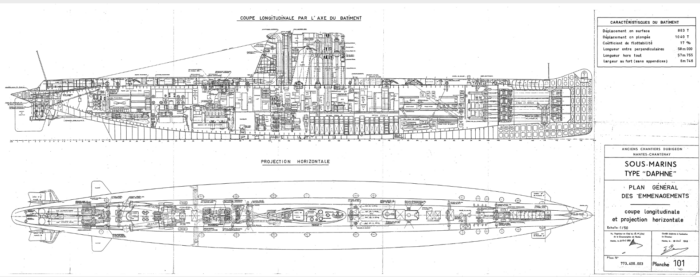
Main view, original plans, now declassified, archives de la marine
The 1950s Aréthuse had been prototype of small, fast, agile and well equipped attack submarines usable in the hunter killer role, and the admiralty soon identified areas of improvements. The next models, still named after ancient mythological figures, were thought as a larger version, much faster and with nearly double the range, leaning more towards the patrol models, as a sort of good go in-between. They concentrated all what was learned with the first two classes. They were also seen as a second class Narval class, as mid-oceanic capable. Maneuverability was still part of their capabilities as well as a lower noise production, and ease of maintenance. Just like the Oberons, despite their inheritance, they became the quieter French submarine class ever built, with all soundproofing measures applied, like the powerplant mounted on rafts.
Their maintenance system was based on modular replacement, with better automation which enabled to reduce crew numbers, work hours between operational sorties, increased habitability, at the price of of no reloads for their torpedo complement. They departed with their tubes already filled. They were countless differences with the Arethuse making them closer to the Narval class as a sort iof “universal design” wich explained their large production as well. They were supposed to dive deeper than the Narvals, but ended less deep than the Arethuse, yet still around 300m.
The design from Direction des Construction Navales or directorate of naval construction signed by chief engineer André Gempp, already designer of the bathyscaphe FNRS 3, and later the first French SSBN of the Gymnote class and the Le Redoutable class, was probably the pinnacle of the “classic” post-Type XXI 1950s design that all navies embraced.
Hull and general design
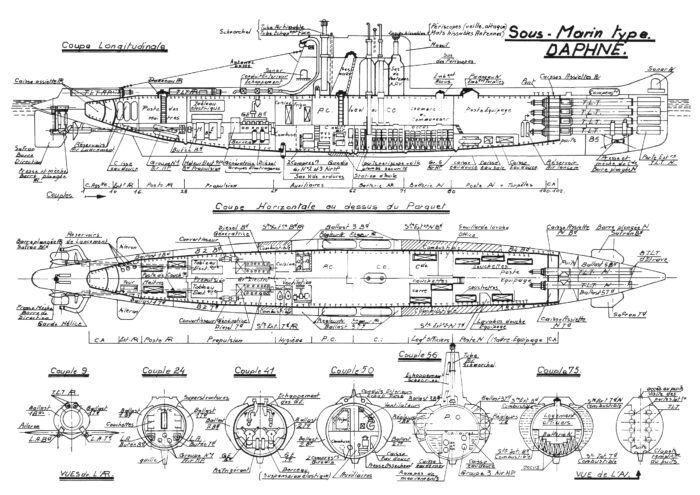
Three views plan. I’m searching of the full set.
Albeit their general shape was about the same as the previous two designs, the Daphné class were an interesting in-between. At 57,75 m long and 870 tonnes they were certainly smaller than the Narval class (78.4 m, 1635t) made to patrol the French Empire postwar, but larger than the Arethuse class (49.6 m, 552t), which were essentially Mediterranean hunter killers. Other change compared to the latter, they had like the Narval class a two-propeller, two diesel-electric sets powerplant. This gave them certainly a greater chance of survival in case of breakdown, and greater agility as well. For the rest, they shared the same streamlined hull much inspired by late WW2 designs such as the Type XXI and XXIII. The profile was somewhat marred by the presence of a prominent dome at the bow, but this was no different from the Oberons. Neither UK nor France embarked at the time in the teardrop shape.
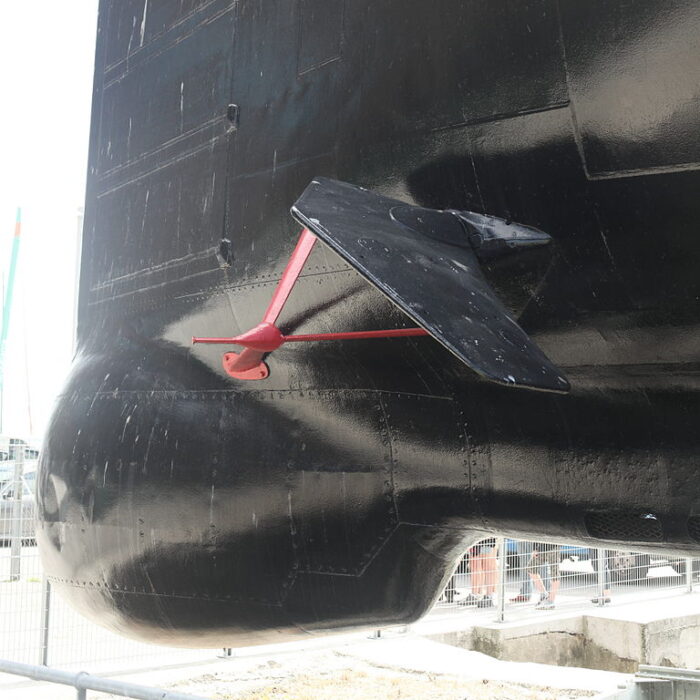
They were two stage submarines, with the upper one mainly housing the crew and lower one housing the engines aft and batteries (under the CP and sail). The torpedo room was so tall it occupied the entire foward section of the pressure hull. There were crew post behind and the outer hull external torpedo loading port. Like the RAS (respenishment at sea) it was envisioned to reload torpedoes when deployed abroad the same way. The sail had a small protected bridge under the open bridge above with windows. There were two main periscopes, communication antennae behind the access chamber, and snorkel at the rear of the sail. The retractable radar was at the forward end of the sail. The galley was located aft of the small mess and command post. There was another command post located aft of it, to manage the generators, diesels, and auxiliaries below. The rear crew posts were also located there. Large compressed air bottles were located on the lower aft end and forward lower end of the pressure hull. Diesel oil tanks were located in the heavily compartimented (44 sections) outer hull keel.
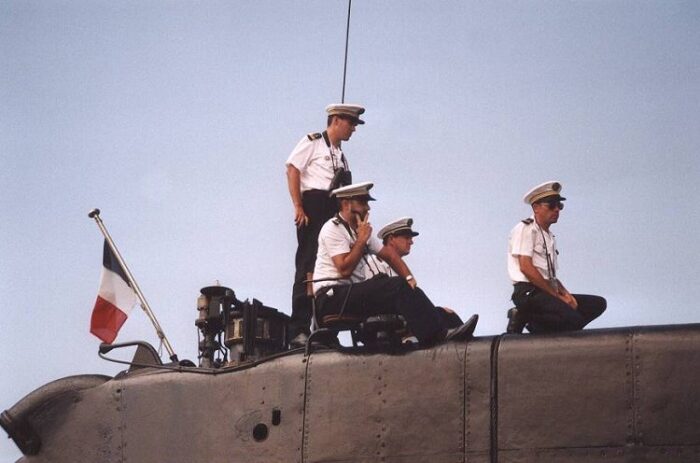
The submarine staff on top of the sail underway off Toulon
Like previous boats, they also had a tall and narrow sail, and forward bottom, rear bottom diving planes. But the greater difference was in their armament. Whene the Arethuse had only four bow tubes due to her small size, the Daphne class returned to a greater armament, even superior to the larger Narval, of twelve 550 mm (22 in) torpedo tubes instead of eight (6 bow & 2 stern). Engineers managed to fit no less than eight torpedo tubes at the bow, with four either beam, which was a record for the time, and like the previous Narval, two defensive tubes aft. However unlike the Narvals and Arethuse, they carried no reloads at all. The torpedo room was severely reduced to maintenance and control. So instead of 14 torpedoes they “only” carried 12 torpedoes of the latest French designs (see below). The pressure hull had seven main bulkhead separations. The crew comprised 6 officiers, 24 NCOs and 20 ratings. They shared by quarters 4-stage superimposed bunks. Officers were housed in individual cabins forward, close to the CP.
Powerplant
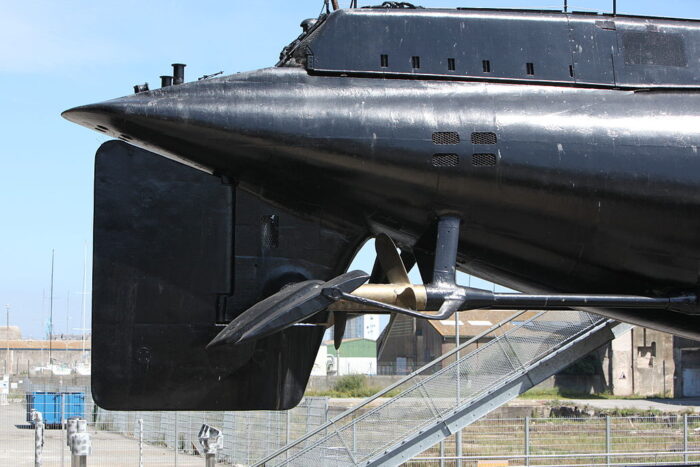
The Daphne class were powered by two SEMT-Pielstick (Pielstick-Jeumont-Schneider) diesel engines, coupled with two 450-kilowatt diesel generator sets, and two electric motors which actually turned two shafts for 750 kilowatts (1,000 shp) sustained and up to 970 kW (1,300 shp) for short periods if needed for faster runs. The first seven had the SEMT-Pielstick 12 PA1 diesels and the final two ghad the improved SEMT-Pielstick 12 PA4-135 type. Performances were marginally better, consumption improved but overall vibrations were down. The final diving depth was less than hoped at 300 m (980 ft), sisomewhat compromised eventually, but they could remain at sea for 30 days, more than the cramped Arethuse. They could reach a top speed of 13.5 knots (25.0 km/h; 15.5 mph) surfaced, 16 knots (30 km/h; 18 mph) submerged with a range of 4,300 nautical miles (8,000 km; 4,900 mi) at 7.5 knots (13.9 km/h; 8.6 mph) under snorkel, so semi-submerged, providing the weather allowed it.
The batteries total power reached 10,000 AH at low regimes. They were located in two separate rooms each with several rows of nine accumulators going all the internal beam for 160 type L cells total. There was a small access tube for inspection located aft of the rear battery room. Both rooms had fire detection and gas evacuation pumps.
Armament
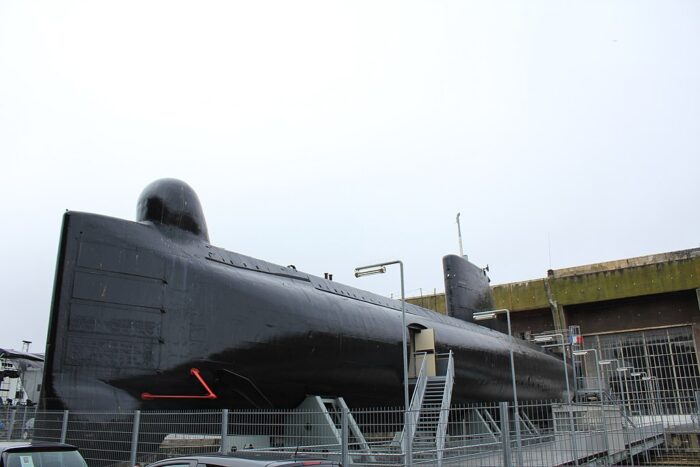
Forward tubes and view of La Flore in Lorient
The Daphne class submarines were better armed than the Arethuse, and even compared to the larger Narvals. They had an unprecedented twelve torpedo tubes: Eight were located in the bow, all four tubes either side top to bottom of the short tortpedo room behind, instead of four and two or more in the outer hull as previous designs. Such numbers were not seen since the British T class of 1937. Four more were located in the stern for defensive purposes. These were the same 550-millimetre (21.7 in) torpedo tubes, none with reloads. Compared to the original specs, that too was a severe compromise as the initial design called for 14 spares. The stern tubes were echeloned with two pairs of ports aft in the outer hull.
These were of the E12 (early) E14 (standard) and L3/L5 (from 1970-80s) acoustic models, and the F17 wire guided model.
The tubes were made for silent launch via a rammer, and at maximum speed and immersion of 300 m.
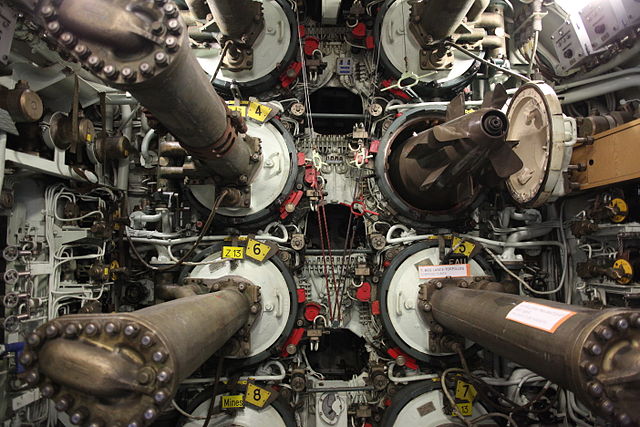
E14 acoustic Torpedo
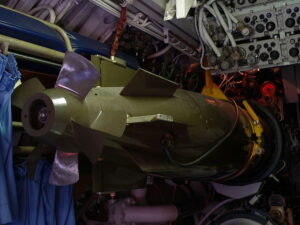 The Narval’s E12 was the first French passive homing torpedo, being launched with already a firing solution delivered within 770 yards (700 m) of the target, developed based from captured German models such as the T-5. It was electric, and range was priomordial over speed, with justy 25 knots.
The Narval’s E12 was the first French passive homing torpedo, being launched with already a firing solution delivered within 770 yards (700 m) of the target, developed based from captured German models such as the T-5. It was electric, and range was priomordial over speed, with justy 25 knots.
The E15 was an export variant of the E12, and the E18 had an improved passive seeker head, but it was only used on the Arethuse class.
In regular early service, these subs carried the E12 and E14.
The E14 entered service in 1960 and was a smaller version of the E12, tailored for the Arethuse class and modified at least twice in 30 years, swapping their silver-zinc batteries models and engines to double the range and increase the speed by 10 knots. They were also fitted with better seeker-heads and larger warheads.
⚙ specifications 55 cm E14
Weight: 3,637 lbs. (1,650 kg)
Dimensions: 4.28 m x 55 cm (168.5 inches long)
Propulsion: Nickel Cadmium Battery
Range/speed setting: 5,500 yards (5,000 m)/25.5 knots
Warhead: 440 lbs. (200 kg) aluminium Tolite
Guidance: Initial data, passive homing
The export versions were fitted with the E15, which diverged somehwat from the E14, being loger and more powerful, much longer range:
⚙ specifications 55 cm E15 (export)
Weight: 3,637 lbs. (1,650 kg)
Overall Length: 232.3 in (5.9 m) long, same diameter as above.
Warhead: 660 lbs. (300 kg) Aluminum Tolite or HBX-3
Range/Speed: Nickel-Cadmium Battery for 13,000 yards (12,000 m)/25 knots
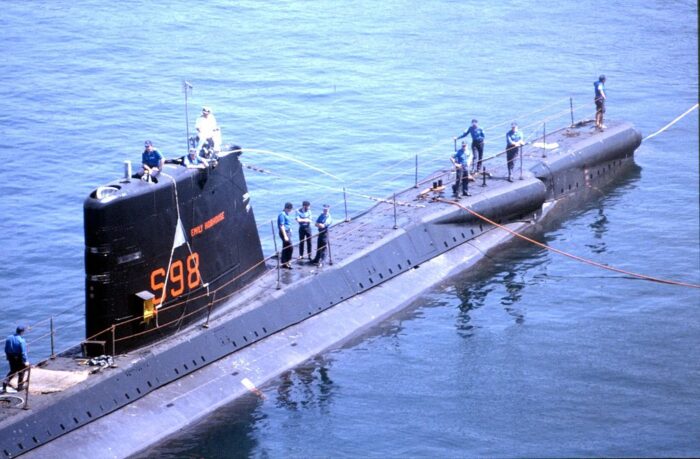
Detail showing the rear external tubes
L3 Acoustic Torpedo
The replacement for the E15, entering service in 1960, as some of the Daphne class were completed. Quickly replaced the E15 in service. They were those fitted in the stern tubes for short range defense. They were also exported with the later Daphne class for various navies.
⚙ specifications 55 cm L3
Weight: 2,006 lbs. (910 kg), for 170.1 in (4.320 m) long x 55 cm.
Warhead: 440 lbs. (200 kg) Tolite A1
Nickel-cadmium Battery for 5,500 yards (5,000 m) at 25 knots.
Given the tubes caliber, they could also have used the 53 cm L5 proposed in 1971 (mod 1-3) and 1980 (mod 4), with a better range at 7000 or 10,000 yards at 35 knots depending on the mods, carrying the same 440 lbs. (200 kg) HBX-3/TNT payloads but with better acoustic search range and resistance to ECM and decoys.
F17 Wire guided Torpedo
This was essentially the first French Wire-guided dual-purpose torpedo, using also a active-passive terminal homing when the cable was dropped.
They evolved with the Daphne class.
⚙ specifications 55 cm F17
Weight: 3,108 lbs. (1,410 kg), lenght 236 in (6 m long) x 55 cm
Warhead: 551 lbs. (250 kg) HBX-3
Propulsion: Zinc-silver oxide batteries for a base 19,700 yards (18,000 m) at 35 knots, 31,700 yards at 24 kts under wire.
The F17 Mod 1 was tested from 1969 and introduced in 1973:
Specs: 323 in (5.900 m) long, range/speed 22,000 yards (20,000 m)/35 knots.
The Mod 2 arrived in 1988 and was shorter at 212 inches (5.384 m) long, for 22,000 yards (20,000 m) at 40 knots.
Th F17P Mod 2 introduced sooner in 1985 was longer at 221 inches (5.62 m) for 32,000 yards (30,000 m) at 35 knots.
Some tested fiber optic cables, not adopted.
Any Daphne carried a set of L3s and F17s of various range and speed prior to decommission in 1990.
They could not operate the Exocet SM39 though, making them less appealing for 1990s standards.
Sensors
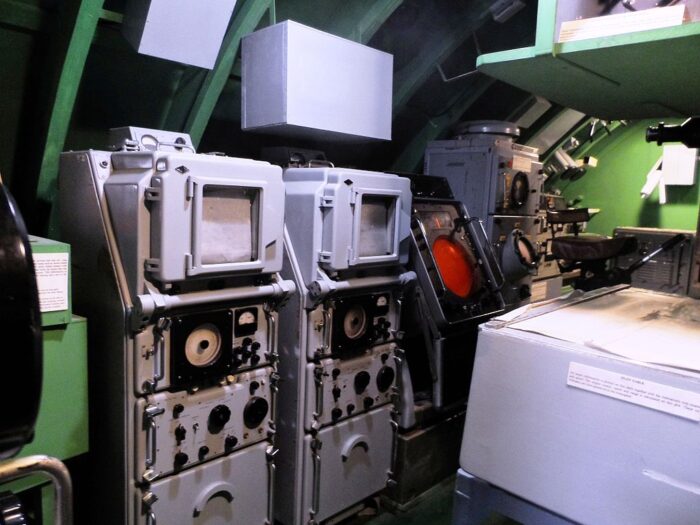
Operation Room (South African Daphne)
The Daphne sported the DRUA 33 radar and its mast in the sail, as well as a DUUA 1 sonar in the hull, to be precised, located in the chin’s plastic radome. Its shaped was tested and restested for the optimal shape. From 1971, this set was modernized: They obtained the DUUA 2B search and attack sonar in a rewoked some atop the bow. This gave the prow a twin prominence top and bottom of the straight bow which resembled a hammerhead shark. The Daphne class also received the updated DLT D3 torpedo fire control system. Next, they wete fitted with DSUV 2 passive sonar and DUUX 2 acoustic telemeter. They DUUA2B sonar forced to adopt a larger bow dome while the DLTD3A allowed the launch of the new F17 wire-guided torpedoes.
Underwater detection comprised fropm the start a microphone array and acoustic rangefinder but in 1977 Doris tested the “Fénelon”, a third-generation rangefinder created by CIT-Alcatel as well as a modern sonar. As standards were a goniometer, a frequency analyzer and cavitation detector.
From 1971 the new fire control system was the CIT-Alcatel DLT D-3 coupled with the radar and radar emission interceptor to detect incoming air threats.
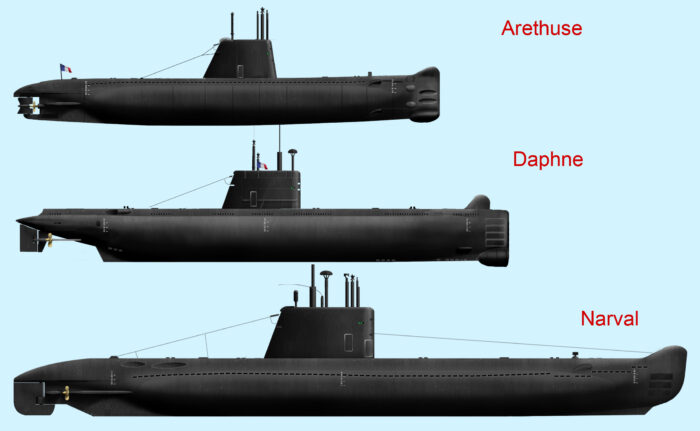
A self-explanatory comparison between the Narval, Arethuse and Daphne class.
⚙ Daphne specifications |
|
| Displacement | 700 t standard, 860 t surfaced, 1,038 t submerged |
| Dimensions | 57.75 x 6.76 x 5.25m (189 ft 6 in x 22 ft 2 in x 17 ft 3 in) |
| Propulsion | 2 shafts Diesel-electric 1,000 shp (750 kW) |
| Speed | 13.5 knots surfaced, 16 knots submerged |
| Range | 4300 nm (8,000 km; 4,900 mi) 7.5 kn snorkel, autonomy 30 days |
| Armament | 8+4 550 mm (21.7 in) torpedo tubes (12 torpedoes carried) |
| Max depth | 300m (980 ft) |
| Sensors | DRUA 31 radar, DUUA 2B sonar, DSUV 2 passive sonar, DUUX acoustic telemeter |
| Protection | ARUR 10B radar detector |
| Crew | 45 |
General evaluation
Constructed at three shipyards in France, eleven in the arsenals of Cherbourg and Brest, including three at the Dubigeon shipyards in Nantes. The first entered service in 1964 and the last in 1970. Two French submarines were lost: Minerve in 1968 and Eurydice in 1970. All of the remaining submarines underwent modernization beginning in 1971. Sirène sank in 1972 at Lorient, but was salvaged. The boats were planned for disposal in the 1980s, however, the slow delivery of their nuclear submarine replacements led to their careers being extended.
A significant number of accidents occurred on board, some causing the loss of Minerve and Eurydice.
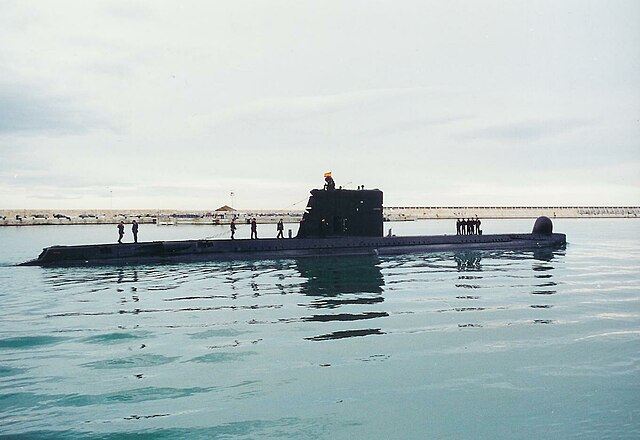
On January 27, 1968, Minerve was lost southeast of Cape Sicié SE coast, with all hands (52 submariners). The search for the wreck began on July 3, 2019 and on July 4 at 7:10 p.m. she was located under 2,350 meters, officially found on July 21 after an underwater drone conformation. It was loaned to Seabed Constructor to conduct the search.
On March 4, 1970, Eurydice was lost with all hands Saint-Tropez, same SE coast with all hands (57 souls). The search started earlier and her wreck was located and explored in April 1970 under 750 meters. The causes of these two accidents have never been clearly identified but it certainly contributed to greater vigilance in operations with new safety procedures, hence the absence of any other accident for the next classes. There was nothing of the scope of SUBSAFE but it certainly had an influence on the submarine command from 1970.
Exports
The export market changed postwar, Italy was out and the US only sold used designs. This left UK, Germany and France as the only countries with the extra shipbuilding capability and know how for export. In the 1960s, the United Kingdom marketed its Oberon towards the commonwealth and beyond, Germany did the same a bit later, and expecially with the 209, whereas the French offered the Daphné class. The Oberons were found in general more expensive and more difficult to operate compared to the French boats. Smaller navies opted for the Daphne for its simplicity, rusticity, ease of maintenance and lower operation costs. In the case of Spain, Oberons was the first choice but this was for political reasons rejected by Downing street. Indeed both Germany and Britain refused to sell hardware to authoritarian regimes or widely cricitized ones like South Africa, unlike France. The acquisition of French submarine by Spain led to a better collaboration between the two navies in the next decades (starting with the acquisition of the Agosta class) leading to Spanish-built designs in the wake of the Scorpene class, still conventional designs, of the 3rd generation.
 Pakistani Navy Hangor class (1967)
Pakistani Navy Hangor class (1967)

Initially these were the Portuguese ordered and named Cachalote, but finanicing delays meant they were instead resold n the fly to Pakistan in 1975, renamed Ghazi. Sometimes dubbed the Hangor class, these three submarines built in France for Pakistan saw a last one repurchased from Portugal in 1975. The first three ordered were the first Pakistani submarines, opposed to Indian Kalvari-class submarines acquired from 1967 and of the Foxtrot class. There was already a Pakistani submarine named Ghazi in service during the Indo-Pak war of 1965, former Tench class GATO II fleet sub. When she sank by accident, she was replaced by a Portuguese submarine in 1975 and modified in France for Pakistani service. They were indeed all tailored for Pakistan, given more modern 12 PA4-135 type diesel engines. The crew comprised 5 officers and 45 sailors and accomodations were different interior differed from the French model in order to meet Pakistan’s requirements. The fourth was acquired from Portugal in 1975 as said above. They were ready and played their part in the 1971 Indo-Pak war: PNS Hangor sank the Indian frigate INS Khukri. This was the only action in anger of the whole Daphne class. By the late 1980s they were modified in the US to be capable of firing not only antimissile misiles and the encapsulated Sub-Harpoon. They were among the last retired, in 2006.
S131 PNS Hangor: Built at Brest Naval Dockyard, Brest, laid down 1 December 1967, launched 28 June 1967, completed 12 January 1970. Pakistan Maritime Museum
S132 PNS Shushuk: Built C.N. Ciotat, Le Trait laid down 1 December 1967, launched 30 July 1969, comp. 12 January 1970, Decom. January 2006.
S133 PNS Mangro: same, laid down 8 July 1968, launched 7 February 1970, comp. 8 August 1970, Decomm. January 2006
S134 PNS Ghazi: Dec. 1975 former NRP Cachalote transferred 17 January 1977. Decom. January 2006.
 Portuguese Navy: Albacora class (1966)
Portuguese Navy: Albacora class (1966)
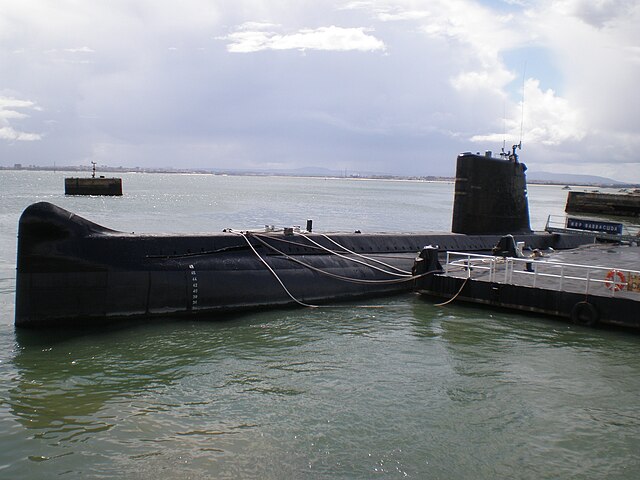
NRP Barracuda at Cacilhas dock in 2012
The four Albacora-class submarines were ordered by the Portuguese Navy in 1964, built on the Daphné design with some modifications to requirements. Construction at Dubigeon Yard in Nantes, West Coast, was fast thanks to prefabricated design, component sections being made between 1 October 1964 and 6 September 1965. They all had SEMT-Pielstick 12 PA1 diesel engines and tropicalized as Portugal was still engaged in its African colonial wars in Mozambique and Angola. In 1975 Portugal sold Cachalote to Pakistan.
S163 NRP Albacora Dubigeon, Nantes, laid down 6 September 1965, launched 13 October 1966, comp. 1 October 1967. Decom. 2000. Sunk at moorings.
S164 NRP Barracuda laid down 19 October 1965, launched 24 April 1967, com. 4 May 1968, Decom. 2010, now a museum in Lisbon.
S165 NRP Cachalote was laid down on 27 October 1966, launched on 16 February 1968 completed on 25 January 1969, sold in December 1975 to Pakistan
S166 NRP Delfim was laid down on 14 May 1967, launched on 23 September 1968, comp. 1 October 1969, Decom. 2005.
 South African Navy: Maria van Riebeeck class (1969)
South African Navy: Maria van Riebeeck class (1969)
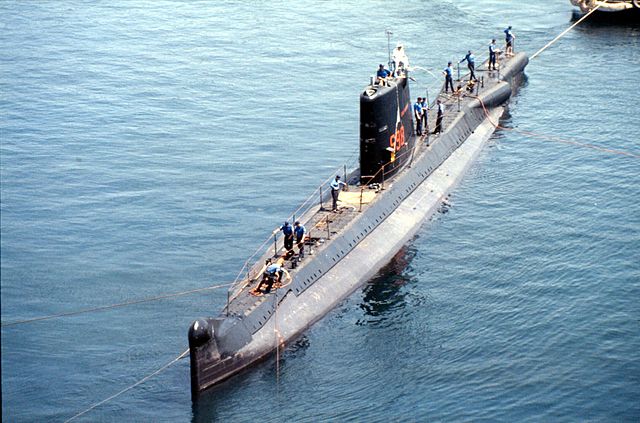
SAS Assegaai as SAS Emily Hobhouse c. 1994
After South Africa became a republic in 1961, the country left the Commonwealth due to its Partheid policy and the UK refuse to sell it any military equipment. South Africa turned to France whihc provided assistance to build a submarine base at Simonstown, and negociated the purchase of three Daphné boats in 1967 to Chantiers Dubigeon, Nantes, also built in modules and shipped there for final assembly. This made these first submarines ever constructed in South Africa. They were initially called the Maria van Riebeeck class with a crew of 47, including 6 officers and were later modernized locally with updated sonar and displays (notably with the help of israel) in the 1980s. Emily Hobhouse was the first so modernized in 1988, Johanna van der Merwe in 1990 and Maria van Riebeeck in 1992. In 1980, South Africa also attempted to acquire two Portuguese Daphne. They were all renamed after the end of the Apartheid.
S97 SAS Spear ex-Maria van Riebeeck was laid down on 14 March 1968, launched on 18 March 1969, comp. 22 June 1970, Sold for BU 2002.
S98 SAS Umkhonto ex-Emily Hobhouse was laid down 18 November 1968, launched 24 October 1969, comp. on 25 January 1971n, scrapped in 2003.
S99 SAS Assegaai ex-Johanna van der Merwe was laid down on 24 April 1969, launched on 21 July 1970, comp. 21 July 1971 and decommissioned 2003, museum ship opened in 2008.
 Spanish Navy: Delfin class (1972)
Spanish Navy: Delfin class (1972)
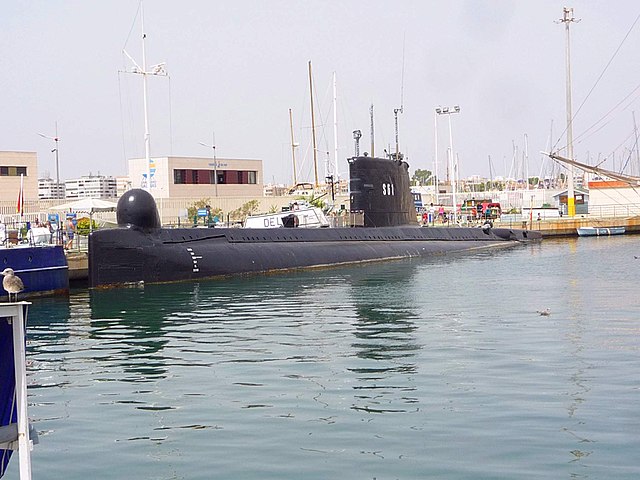
Delfín as a museum ship
Spain was an early pioneer of submarines and had several times in the interwar, even completing a German design postwar. However between the civil war, WW2 neutrality abnd isolation of the regime in Europe and on the international scene, shipbuilding industry had to restart almost from scratch, and relearn techniques from various sources. US destroyers and submarines were provided, with the idea of acquisiring the British Oberon-class. However this was refused.
Spain turned to the French with an agreement signed on 16 July 1966 for a transfer of technology to build Daphné-class submarines under license in Spain. Consultants were sent from France at every steps. Named the Delfín class or S-60 class they were the last evolution of the Daphen design, well modified with an overall lenght ported to 57.78 m (189 ft 7 in) and a draught of 4.6 m (15 ft 1 in), displacement of 869 t (855 long tons) surfaced, 1,069 t (1,052 long tons) submerged. The first two were ordered in December 1966, two in March 1970 and fifth planned, but never ordered. All four were by built at Bazan, Cartagena. Construction took about 4-6 years on average so when completed in 1973-75 their design dated back 1956. They were also later modernized at Cartagena from 1983 to 1988 with their DUUA 1 sonar replaced by the DUUA 2A and new torpedo fire control, all French. The DUUA 2 had a specific bow dome, but their older DUUA-1D sonar was kept at the rear.
S61 Delfín: Laid down 13 August 1968, launched 25 March 1972, completed 3 May 1973, decommissioned 2003, 2004 museum ship at Torrevieja.
S62 Tonina: Laid down 2 March 1970, launched 3 October 1972, completed 10 July 1973, Decommissioned 2005, museum ship at Cartagena
S63 Marsopa: Laid down 19 March 1971, launched 15 March 1974, completed 12 April 1975, Decom. 2006. Sold for BU.
S64 Narval: Laid down 24 April 1972, launched 14 December 1974 , comp. 22 November 1975, decom. 2003. Sold for BU.
Career of the Daphné class
The Daphne class were poised to served on all threaters, Atlantic, Mediterranean and Indian Ocean, but they were mostly focused on the Mediterranean. At Toulon they required the construction of new facilities. In May 1964, the Chief of Staff laid the first stone of a new section for the Toulon submarine base completed in 1966, called “L’Herminier barracks”. The old Béarn was used as tender until then and scrapped when it was complete and operational.
On November 1, 1970, the 1st squadron (11 boats, comprising the four Arethuse) became the “Mediterranean Submarine Squadron” (later ESMED) with the 2nd squadron, with 6 Narval types, 2 Daphné type kept in Lorient as the “Atlantic Submarine Squadron” (ESMAT). They were colloquially named the “800-tonnes” and modernized from 1971 except the lead boat Daphne, retired earlier.
 S641 Daphné (1959)
S641 Daphné (1959)

Daphné was from Chantiers Dubigeon, Nantes laid down on March 1958, lmaunched on 20 June 1959 and completed on 1 June 1964, Decommissioned 1989. Daphne arrived in Toulon in November 1961, and joined the 1st submarine squadron officially operational on June 1, 1964. She took part in Operation Mousson with the squadron in 1963 (a cruise to Beirut, Djibouti, Aden) and a 1965 mission to the French west indies Antilles in 1965, tendered by the tanker Rhône.
In 1966, she was assigned to the 2nd ESM based in Lorient, Keroman base. Before this she had a short refit at Toulon in 1967-68. This consisted in setting up new diving fins, carrying new torpedoes and installation of new sonars. She was refitted later at Lorient in 1971-72 and Cherbourg in 1979-80 then Toulon again 1983-84, rotating between squadrons.
In May 1972 she was indeed back to Toulon, Mediterranean fleet and deployed on the coast and Thyrrenian sea. She took part in naval reviews on 11 July 1976 and 14 July 1982.
In 1989 she tested the experimental Murena torpedo and on 17 September she made her last operational dive with 16 of her 19 former commanders on board before being withdrawn on 16 October 1989, stricken on September 11, 1990 as Q676, sunk as target off Toulon on November 23, 1994 by a Super-Etendard of the 17F squadron.
 S642 Diane (1960)
S642 Diane (1960)
S642 Diane was from the same yard (Dubigeon) laid down on July 1958, launched on 4 October 1960 and completed 20 June 1964. In June 1962 she joined Toulon and the 1st submarine squadron. By October 1964, she was rotated to Lorient’s SubRon 2 until 1968. On August 1, 1968 she was back to SubRon 1 renamed in 1970, the “Mediterranean submarine squadron” (ESMED).
She had refits in Toulon in 1968-69, 1972-73 (major ones). She had an incident in 1964 underway between Toulon and Lorient and off the Spanish coast while submerged to 55 meters (180 ft). Suddenly, she dropped for a further 48 meters (157 feet) and the cause was not formally identified. She was decommissioned on December 30, 1987, stricken October 22, 1993 as Q673, sold for BU on February 21, 1995 in Lorient. She was purchased for 166,999 francs by Soyer establishments and BU in May-July 1995.
 S643 Doris
S643 Doris
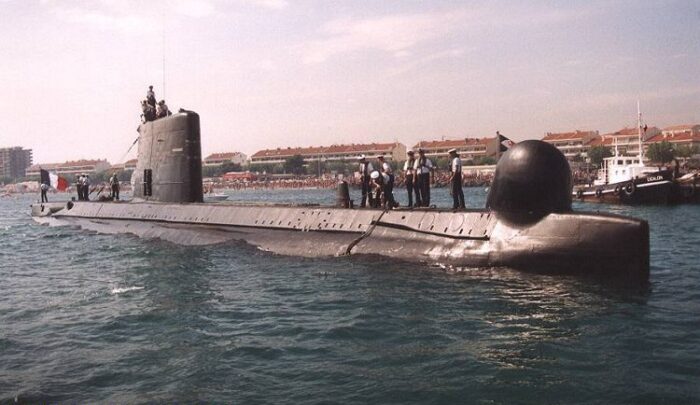
Doris in 1994
S643 Doris was laid down at Cherbourg Naval Dockyard, Cherbourg in September 1958, launched 14 May 1960 and completed on 26 August 1964. She made her shakedown cruise from the 1st to 13th June 1962 between Cherbourg and Toulon, under command of Lt. Lucas and spent her entire career in Toulon, with the 1st submarine squadron, then renamed ESMED. She only keft the base for a refit in 1977-78 in Cherbourg fully modernized. On 25th November 1966, she was boarded by the Soviet tanker Stanislav in the Mediterranean, taking heavy damage to the aft section but the pressure hull remained intact.
On October 22, 1983, while surfaced off Sête, one cell in her battery exploded, resulting in the death of two, injuring five. She was decommissioned on November 18, 1994, stricken on August 20, 1996 as Q718 and ended as target. On June 25, 1999 she was to be sunk by the new new MU90 torpedo while submerged at a shallow depth but accidentally sank by herself while off the island of Levant prior to launch, the very same day and hour.
 S644 Eurydice
S644 Eurydice
S644 Eurydice was laid down on 19 June 1962, launched on 26 September 1964. She left Cherbourg in June 1963 for her skakedown cruise to Dakar, Africa and Santa Cruz in Portugal. On August 14, 1963, she reached Toulon and remained here throughout her career, formally commissioned on September 26, 1964 and assigned to the 1st submarine squadron. On February 8, 1968 she carried General de Gaulle in Toulon for a cruise and dive near the site of the shipwreck of the Minerve, recently sunk.
As a tragic irony on March 4, 1970, was lost following an unknown accident off the coast of Saint Tropez with all hands (57 victims). The wreck was rapidly rediscovered with the help of the US Navy and explored from April 1970 under 750 meters (2,460 ft). Hypothesis ranged from the collision with a cargo ship (the Tunisian Tabarka were examined by divers while in Marseille), accidental water ingress via a faulty snorkel and possible diving plans jamming. It is still not elucidated. A plaque was erected near the site and ceremonies are held yearly.
 S645 Flore
S645 Flore
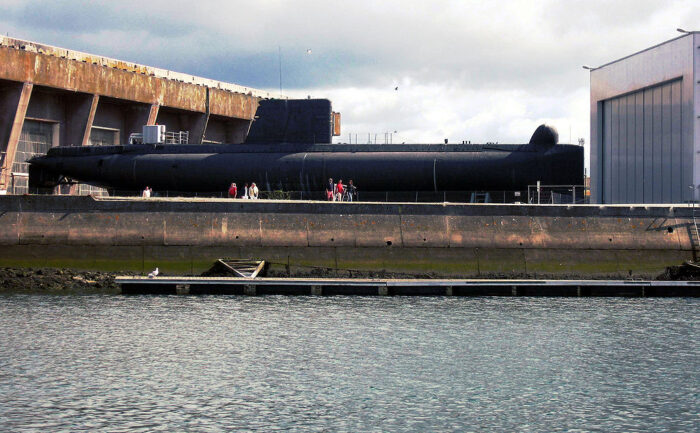
S645 Flore was laid down on September 1958, launched on 14 May 1960 and completed on 26 August 1964. She was the only one of her class preserved as museum ship in Lorient. She was assigned to the 1st submarine squadron in Toulon for all her career with just two trips to Lorient for major refits. She experience accidents during her career: In January 1968, a collision saw the fairing of the passive bow sonar being mushed. On February 19, 1971, she had a severe water ingress off Toulon while at periscope depht. Safety weights of the keel were released so that she could rise to the surface, and be towed to Toulon for repairs. She was placed in reserve in 1988, decommissioned on March 2, 1989. Instead of being sold for BU the city of Lorient proposed to purchase the hull and get fundings for reconversion intoi a museum ship, opened to the public from 1995. The former slipway of Lorient submarine base was entirely transformed into a naval museum and is now the main site to explore these early cold war submarine types. The association MESMAT was created in support and after further work, the “Atlantic submarine museum” opened in turn to the public by May 1, 2010 making a complete site.
 S646 Galatée
S646 Galatée
Galatée (Galatea) was laid down in September 1958, launched on 22 September 1961 and completed on 25 July 1964. Her career mainly took place in the Mediterranean’s 1st submarine squadron but she was temporarily assigned to Lorient in between major refits there. She will see several several accidents. On September 28, 1962, near the Casquets trench in the Channel her aft diving planes jammed and she plunged to the buttom at 60°. Engines were ran full astern, and her bow essentialluy bounced on the sandy bottom at 100 m (330 ft), so well away of her crushing point.
On 21 February 1963, she collided with the Lebanese freighter Seven Stars while at periscope depth. All her sail’s masts were bent and had to be repaired.
On 20 August 1970, she collided with near-sister South African submarine Maria Van Riebeeck off Toulon during sea trials. Six sailors from Galatée died and she had to to run aground at the foot of the Cépet cliff while Maria Van R. which rammed her managed to reach Toulon under her own power. Galatée was refloated and repaired in Toulon.
Galatée was stricken on 22 October 1993 as Q696 and ended as target on 22 October 1998 off Toulon.
 S647 Minerve
S647 Minerve
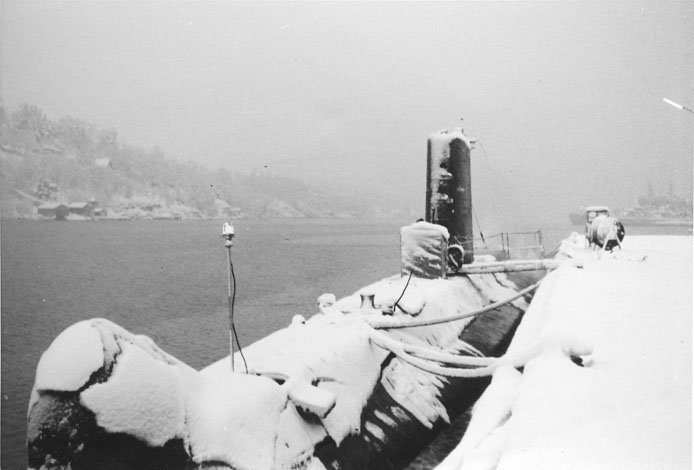
Minerve in Bergen 1962 during her northern waters shakedown cruise
S647 Minerve was built at Chantiers, Dubigeon (defunct 1963, repurchased, closed 1969) in Nantes, laid down on 31 May 1961, launched on 10 June 1964. She was probably the highest profile submarine tragedy of French cold war history, equivalent to the Tresher and Scorpion for the US. Her recent rediscovery led to abundant news and documentaries. She made her shakedown cruise in cold waters at Londonderry, Bergen, Gothenburg by November 1962. She left Cherbourg for Toulon on December 22, 1962, assigned to the SubRon 1 for her short career, officially in service from June 10, 1964, with her only major refit at Missiessy yard in January 1 to October 1, 1967. On January 27, 1968, during an exercise, she disappeared approx. SE of Cape Sicié (Var coast) with all 52 crew. More even than for the loss of Eurydice, her loss caused a deep trauma within the French Navy. General de Gaulle was deeply affected by this tragedy and boarded Eurydice to pay tribute to Minerve on the presumed site of her sinking.
The cause was for long the subject of debate, between collision, water ingress, snorkel failore, dive planes jamming, battery or torpedo explosion. Some argued it was a chain reaction of poorly controlled incidents. Retrospectively, ergonomics, partly due to extreme modularity, were criticized, as the crew was perhaps not prompt enough when reacting to a chain of incidents. The difficulty of training crews at a time with still prewar methods, included for example no simulator on land.
Eventually Minerve was located in 2019 under 2,400 meters deep (7,874 ft), in one of the plateau’s main canyons down to the seabed, 45 kilometers off the coast of Toulon. Since it was well below crushing point the wreck was completely disclocated, giving little clue as how it happened in the first place when explored. The national institute Ifremer and the company Ocean Infinity took part in the exploration. The campaign started iunder then MoD Florence Parly which proposed to relaunch the search to families. Part of it was the rediscovery of the Argentinian San Juan, also lost at great depht. The location was narrowed following a new evaluation of seismic data recorded following the implosion of the Minerve at the time, using modern computing resources. She was found in one of the four squares of researches, the least probable at the edge of the exercise area assigned on the day of her sinking. The Seabed Constructor (same as for the rediscovery of ARA San Juan) led the final phase of explorations with four drones and ROV, mainly from 21 July when it was announced officially. A ceremony was held at sea over the site.
 S648 Junon
S648 Junon
Junon wa slaid down at the Cherbourg Naval Dockyard, in July 1961, launched on 11 May 1964 and completed on 25 February 1966. She was assigned in Toulon, 1st ESM (SubRon 1) but left for Lorient base at ESMAT (Atlantic SubRon) in May 1977, refitted in berween, and back in Toulon at ESMED in October 1991. She had her major overhaul in 1974-75 at Lorient.
Her active service was largely uneventful, except for a collision with a trawler on May 9, 1980, with only slight damage to her outer hull.
She was decommissioned on October 8, 1996, after more than 30 years of service, stricken February 10, 2004 as Q788 and sunk as target on November 22, 2004, by two Exocet MM38 missiles, fired by Dupleix off Toulon.
 S649 Vénus
S649 Vénus
S649 Vénus was laid down at DCAN Cherbourg on August 1961, launched on 24 September 1964 and completed/commissioned on 1 June 1966. From July 21, 1965 to August 10, 1965, she made her shakedown cruise from Cherbourg to Oslo where she stayed from July 29 to August 1 and then to Copenhagen August 3 to 7 before reaching Toulon on September 8, 1965, effective service by January 1, 1966 with SubRon 1 and later ESMED from 1970. In 1969-70 she was back in Lorient for a refit. From January 1, 1978 she was permanetly based at the Atlantic submarine squadron in Lorient. She also made missioned in the Indian Ocean. She was decommissioned after 24 years of service on December 3, 1990, stricken March 11, 1996 as Q714 and ended as target on June 20, 2002, by a mine off the coast of Lorient under 2000 meters.
 S650 Psyché
S650 Psyché
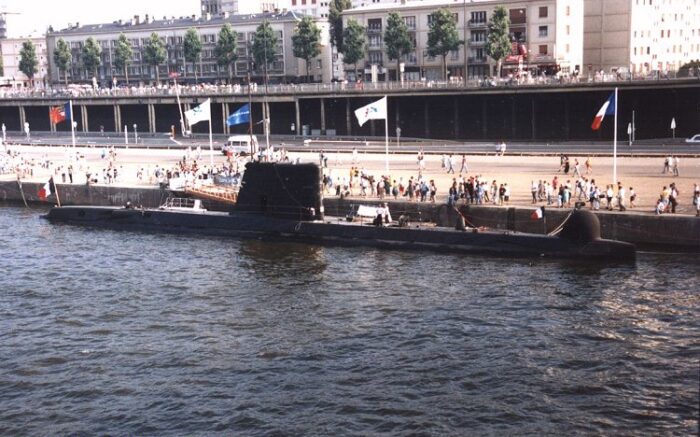
Psyche opened to visitors in Rouen, 1994
S650 Psyché was the first of the last boats built in her class at Brest Naval Dockyard, Brest laid down on May 1965, launched on 28 June 1967 and completed on 1 July 1969, in service from 7 June 1970. She was assigned to the Lorient base and Atlantic submarine squadron until dissolved in 1995 and then Toulon to end her career.
She had a mainb overhaul modenrization in 1981. In the 1990s, she tested a new optronic mast from Sagem. In 31 years of service she spanned the globe with some highlights like the Okoumé mission off West Africa between Agadir, Dakar, Abidjan in January-June 1987, South-East Asia from June to November 1989, notably demonstrations for the Malaysian Navy looking for submarines. Shje was in the west indies from October 1994 to March 1995, managing to breach in an exercise the ASW escort of the aircraft carrier USS Theodore Roosevelt and “torpedo” the carrier. The SSN Saphir did the same in 2015. Psyche was decommissioned in Toulon on September 29, 1998, stricken on December 16, 2002, ended as target on April 29, 2005 off Toulon by 100mm gunfire and finished off by the Mine Clearance Divers Group.
 S651 Sirène
S651 Sirène
S651 Sirène was the second built at Brest and last in French service. She was laid down in May 1965, launched on 28 June 1967 and completed by 1 March 1970. After a long skhakedown cruise from July 28, 1970 to August 31, 1970 under command of Lt.Cdr Brun, she was commissioned on September 3, 1970. Her early career was marked by an accident due to human error on October 11, 1972 while in dock in Lorient, a major leak started at one of her forward torpedo tubes after a faulty procedure. Despite efforts to seal it, she was to be evacuated before sinking. Salvage operations in October were followed by repairs until 1974. She was based at Lorient with ESMAT for her entire career with refits from January 1996 to January 1997, and left left Keroman base when it closed for Toulon on March 10, 1997, to be decommissioned soon after on May, 30, stricken on September 26, 2005, and spent as target.
Read More/Src
Books
Conway’s all the world fighting ships 1947-1995 p121.
Le sous-marin « La Minerve », disparu en 1968, a été retrouvé au large de Toulon », Le Monde, 22 juillet 2019
Blackman, Raymond V. B., ed. (1967). Jane’s Fighting Ships 1967–68. Marston & Co.
Friedman, Norman (1984). Submarine Design and Development. London: Conway Maritime.
Lyon, Hugh; Chumbley, Stephen (1995). “Portugal”. Conway’s All the World’s Fighting Ships 1947–1995.
Moore, John, ed. (1976). Jane’s Fighting Ships 1976–77 (79th ed.). Franklin Watts Incorporated.
Preston, Anthony (1995). “South Africa”. In Gardiner, Robert (ed.). Conway’s All the World’s Fighting Ships 1947–1995.
Prézelin, Bernard, ed. (1990). The Naval Institute Guide to Combat Fleets of the World 1990/1991
Sharpe, Richard, ed. (1990). Jane’s Fighting Ships 1990–91 (93 ed.).
Sharpe, Richard, ed. (1996). Jane’s Fighting Ships 1996–97 (99 ed.).
Sturton, Ian (1995). “Spain”. In Gardiner, Robert (ed.). Conway’s All the World’s Fighting Ships 1947–1995.
Links
netmarine.net/ typedaphne/index1
agasm.fr/ Les-800Tversion-2020.pdf
la-flore.fr/fr/
sousmarinvenus.com/
anciens-cols-bleus.net
aadcns.fr/
netmarine.net/ daphne/
seaforces.org /Daphne-class.htm
/static.blog4ever.com pdf
navaltoday.com/ minerve-found-50-years after
meretmarine.com minerve-retrouvee
fr.wikipedia.org
en.wikipedia.org
en.wikipedia.org Doris_(S643) full logs
en.wikipedia.org/ Eurydice_(S644)
en.wikipedia.org/ submarine_Flore
en.wikipedia.org submarine_Minerve_(S647)
Exploration of La Flore, 100+ cc photos
Videos
See also britishpathe.com/
Model Kits
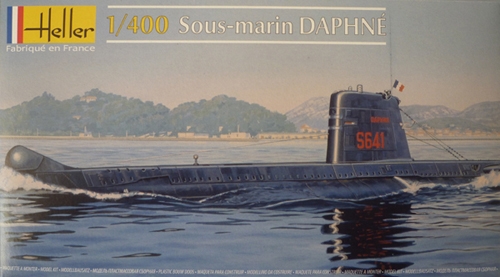
Heller made a kit for years to 1:400, sold out, expired, now rare. L’Arsenal made another one at 1:400, now on sale.

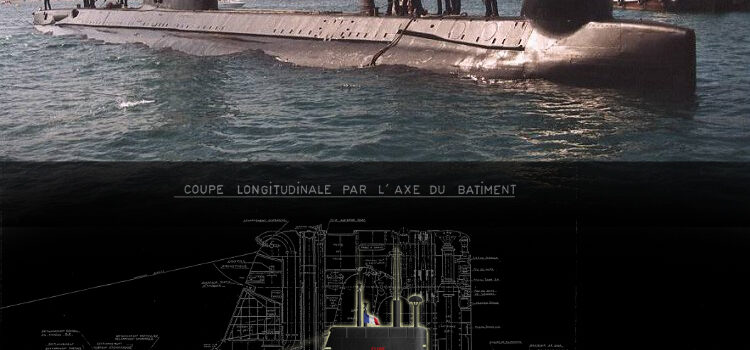



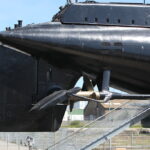
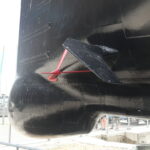
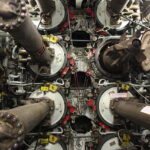
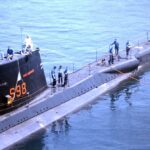
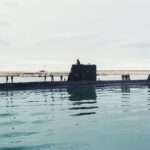
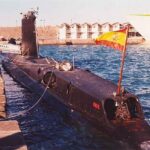
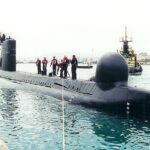
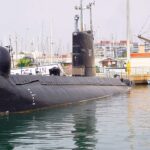
 Latest Facebook Entry -
Latest Facebook Entry -  X(Tweeter) Naval Encyclopedia's deck archive
X(Tweeter) Naval Encyclopedia's deck archive Instagram (@navalencyc)
Instagram (@navalencyc)





 French Navy
French Navy Royal Navy
Royal Navy Russian Navy
Russian Navy Armada Espanola
Armada Espanola Austrian Navy
Austrian Navy K.u.K. Kriegsmarine
K.u.K. Kriegsmarine Dansk Marine
Dansk Marine Nautiko Hellenon
Nautiko Hellenon Koninklije Marine 1870
Koninklije Marine 1870 Marinha do Brasil
Marinha do Brasil Osmanlı Donanması
Osmanlı Donanması Marina Do Peru
Marina Do Peru Marinha do Portugal
Marinha do Portugal Regia Marina 1870
Regia Marina 1870 Nihhon Kaigun 1870
Nihhon Kaigun 1870 Preußische Marine 1870
Preußische Marine 1870 Russkiy Flot 1870
Russkiy Flot 1870 Svenska marinen
Svenska marinen Søværnet
Søværnet Union Navy
Union Navy Confederate Navy
Confederate Navy Armada de Argentina
Armada de Argentina Imperial Chinese Navy
Imperial Chinese Navy Marinha do Portugal
Marinha do Portugal Mexico
Mexico Kaiserliche Marine
Kaiserliche Marine 1898 US Navy
1898 US Navy Sovietskiy Flot
Sovietskiy Flot Royal Canadian Navy
Royal Canadian Navy Royal Australian Navy
Royal Australian Navy RNZN Fleet
RNZN Fleet Chinese Navy 1937
Chinese Navy 1937 Kriegsmarine
Kriegsmarine Chilean Navy
Chilean Navy Danish Navy
Danish Navy Finnish Navy
Finnish Navy Hellenic Navy
Hellenic Navy Polish Navy
Polish Navy Romanian Navy
Romanian Navy Turkish Navy
Turkish Navy Royal Yugoslav Navy
Royal Yugoslav Navy Royal Thai Navy
Royal Thai Navy Minor Navies
Minor Navies Albania
Albania Austria
Austria Belgium
Belgium Columbia
Columbia Costa Rica
Costa Rica Cuba
Cuba Czechoslovakia
Czechoslovakia Dominican Republic
Dominican Republic Haiti
Haiti Hungary
Hungary Honduras
Honduras Estonia
Estonia Iceland
Iceland Eire
Eire Equador
Equador Iran
Iran Iraq
Iraq Latvia
Latvia Liberia
Liberia Lithuania
Lithuania Mandchukuo
Mandchukuo Morocco
Morocco Nicaragua
Nicaragua Persia
Persia San Salvador
San Salvador Sarawak
Sarawak Uruguay
Uruguay Venezuela
Venezuela Zanzibar
Zanzibar Warsaw Pact Navies
Warsaw Pact Navies Bulgaria
Bulgaria Hungary
Hungary

 Bundesmarine
Bundesmarine Dutch Navy
Dutch Navy Hellenic Navy
Hellenic Navy Marina Militare
Marina Militare Yugoslav Navy
Yugoslav Navy Chinese Navy
Chinese Navy Indian Navy
Indian Navy Indonesian Navy
Indonesian Navy JMSDF
JMSDF North Korean Navy
North Korean Navy Pakistani Navy
Pakistani Navy Philippines Navy
Philippines Navy ROKN
ROKN Rep. of Singapore Navy
Rep. of Singapore Navy Taiwanese Navy
Taiwanese Navy IDF Navy
IDF Navy Saudi Navy
Saudi Navy Royal New Zealand Navy
Royal New Zealand Navy Egyptian Navy
Egyptian Navy South African Navy
South African Navy






























 Ukrainian Navy
Ukrainian Navy dbodesign
dbodesign
Hi There.
Would please help me and say where can I get a copy of the drawings for thiis submarine as I wish to build a rc model…. FYI in the photo of the Emily Hobhouse that is me standing forward of the fin!
Hi Richard, as said above, i’m searching myself the full set. I only found only this low res. pic so far, but updated the 1st image with the link to the HD one.
Check this out:
https://naval-encyclopedia.com/wp-content/uploads/2024/09/Daphne_Plans_HD.png
https://naval-encyclopedia.com/wp-content/uploads/2024/09/Daphne_class_plans.jpg
Is that you there ? https://www.saairforce.co.za/forum/viewtopic.php?t=6619
Best